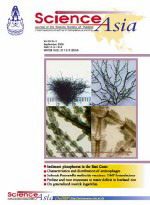ThaiScience
ThaiScience
SCIENCE ASIA
Volume 46, No. 01, Month FEBRUARY, Year 2020, Pages 72 - 79
Electrochemical dna biosensor for detection of pork (sus scrof) using screen printed carbon-reduced graphene oxide electrode
Yeni W. Hartati, Tia A. Setiawati, Titin Sofyatin, Fitrilawati Fitrilawati, Anni Anggraeni, Shabarni Gaffar
Abstract Download PDF
The identification of pork in foodstuff is critical regarding the counterfeiting of meat and kosherness, which is a particular concern for certain religions. In this study, we developed an electrochemical detection method of pork DNA without the use of DNA amplification by using screen printed carbon-reduced graphene oxide (SPC-RGO) electrode. The probe DNA of CytB gene of S. scrofa mtDNA was immobilized on the SPC-RGO surface by passive adsorption. Differential pulse voltammetry (DPV) was used to characterise the probe-target DNA hybridisation based on the target’s guanine oxidation signal. The Placket-Burman and Box Behnken designs were used to select the factors that influence the hybridisation of probe-target DNA and to optimise each parameter. The following findings regarding the several factors that influence the hybridisation process and optimum condition were obtained: 5.0 µg/ml of probe DNA, 6.0 min of immobilisation time of probe DNA, 20.0 min of probe-target hybridisation time, a scan rate at 0.5 V/s, the pulse amplitude at 50.0 mV, and the washing time of the electrode being as long as 40 s. The limit of detection was obtained at 1.76 µg/ml for the linear range of 0–10.0 µg/ml target DNA while the relative standard deviation (RSD) was 2.25%. The DNA biosensor was tested on the isolated DNA samples from pork, chicken and beef while the voltammetry response reveals that it can distinguish the samples. These results indicate that the proposed electrochemical DNA biosensor has the potential to develop the detection method of pork content in the food samples.
Keywords
DNA biosensor, pork, voltammetry, SPC-RGO electrodeSCIENCE ASIA
Published by : The Science Society of Thailand
Contributions welcome at : http://www.scienceasia.org/
